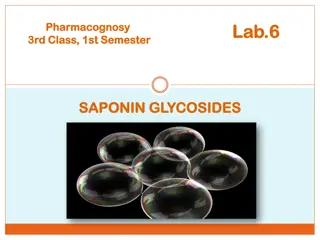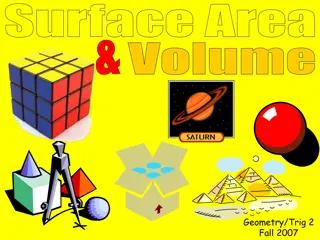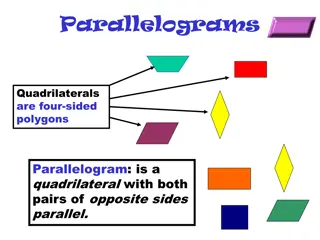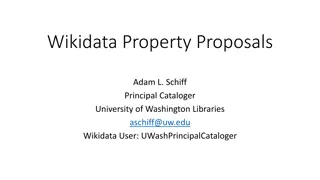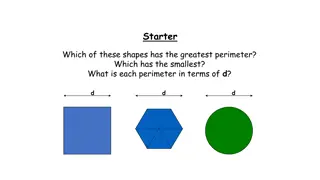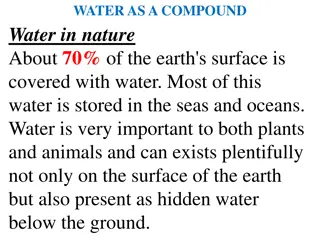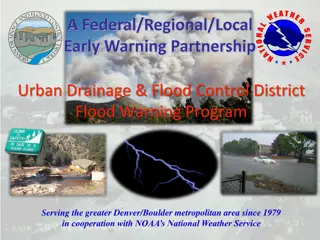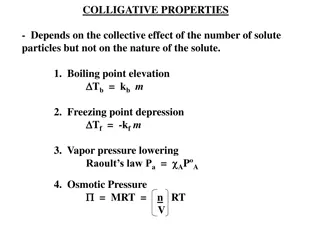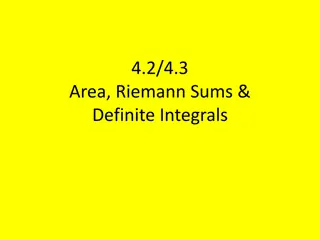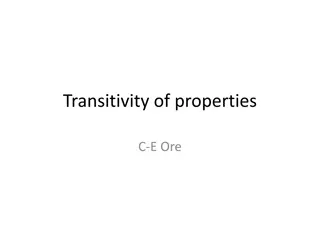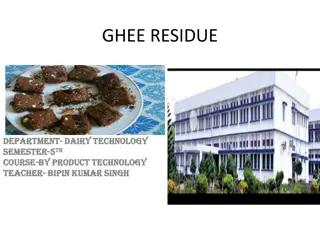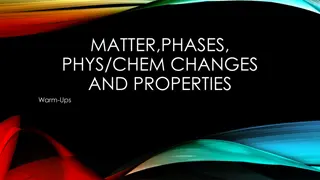Understanding the Rule of Mixtures in Composite Materials
The Rule of Mixtures (ROM) is a weighted method for predicting the properties of composite materials, such as fiber-reinforced polymers (FRP). This method relies on assumptions regarding the homogeneity and properties of fibers and matrices. By combining volume fraction and properties linearly, the
5 views • 23 slides
Understanding Saponin Glycosides in Pharmacognosy: Properties and Applications
Saponin glycosides, found in various plants, are compounds with diverse benefits ranging from cholesterol regulation to potential anticancer properties. They form colloidal solutions in water and are used in soap manufacturing due to their unique properties. Additionally, saponins have bitter taste,
7 views • 18 slides
Understanding Properties and States of Matter in Physical Science
Matter is made up of elements that cannot be broken down further. Different mixtures have distinct properties, such as solutions, colloids, and suspensions. Physical properties like viscosity and density can be observed without changing the material's composition. Chemical properties, like flammabil
2 views • 15 slides
South East Asia Collagen
Collagen, with its unique properties, has been extensively used in food processing industries. These properties are usually categorized into two groups. First, the properties associated with its gelling behavior, such as texturizing, thickening, gel formation, and water binding capacity, and second,
0 views • 2 slides
Guidelines for Handling Case Properties and Seized Assets in Legal Proceedings
This informative content discusses the handling of case properties involved in offenses, including seizure, custody, disposal, and coordination among government departments. It covers various aspects such as the types of case properties, custody procedures, provisions under Section 516-A Cr.PC, and
0 views • 8 slides
Understanding Surface Area and Volume in Geometry
Gain insights into calculating surface area and volume of geometric shapes, specifically focusing on rectangular prisms. Learn how to find surface area and lateral area using formulas, and explore examples illustrating these calculations step by step with images.
1 views • 57 slides
Understanding Colloidal Dispersions in Physical Pharmacy
Colloidal dispersions consist of particulate matter distributed throughout a medium. They can be classified based on particle diameter, with molecular, colloidal, and coarse dispersions being common types. The enormous surface area of colloidal particles leads to unique properties, such as catalytic
1 views • 69 slides
Exploring Length and Area Concepts in Year 7 Maths
Delve into the world of measurements, accuracy limits, and area calculations in Year 7 Math. Learn about the accuracy of measurements, limits of accuracy, calculating the area of shapes, converting units of area, and investigating the area of triangles. Explore practical examples and understand the
0 views • 20 slides
Understanding Area of Shapes through Rectangles
This educational session focuses on learning to calculate the area of shapes by counting rectangles. It covers concepts of perimeter and area, providing visual examples and challenges to reinforce understanding. Students will engage in activities to practice determining the area of various shapes by
0 views • 35 slides
Understanding Furan and Thiophene: Structures, Properties, and Uses
Furan and Thiophene are important heterocyclic organic compounds with distinct structures and properties. Furan, a five-membered aromatic ring, is used in specialty chemical production and has unique physical properties. Thiophene, a sulfur-containing compound, finds applications in agrochemicals an
2 views • 8 slides
Classification of Elements and Periodicity in Properties: Overview and Evolution
The journey of understanding the classification of elements and periodicity in properties begins with early laws like the Law of Triads and Newland's Law of Octaves. Mendeleev's Periodic Law revolutionized the organization of elements, leading to the modern periodic table. Discoveries of eka-alumini
3 views • 32 slides
Understanding Parallelograms: Properties, Theorems, and Tests
Parallelograms are four-sided polygons with unique properties that include having both pairs of opposite sides parallel. Explore key theorems, tests, and properties of parallelograms such as opposite side and angle congruency, diagonal bisecting, and conditions for identifying a quadrilateral as a p
1 views • 19 slides
Advancements in 2D Nanomaterials Research
Advancements in the field of 2D nanomaterials, beyond graphene and transition metal dichalcogenides (TMDs), have attracted significant attention. Researchers explore various 2D materials with unique properties and applications. The categorization of 2D materials into layered and non-layered structur
0 views • 21 slides
Understanding Physicochemical Properties of Drugs
The physicochemical properties of drugs play a crucial role in their pharmacological effects. These properties include physical and chemical characteristics that influence interactions with biomolecules. Solubility, partition coefficient, and dissociation constant are key factors affecting drug beha
1 views • 46 slides
Algebra Rules and Properties
Explore the fundamental rules and properties of algebra and indices, including commutative, associative, and distributive properties. Learn about negation, zero properties, and the zero factor property, illustrated with examples and common errors. Engage in activities to apply and test your understa
1 views • 21 slides
Understanding Area and Perimeter in Geometry
Area and perimeter are important concepts in geometry. Area refers to the space inside a two-dimensional shape, while perimeter is the distance around the shape. Formulas and examples for calculating perimeter and area of rectangles and squares are provided in the content. Watch the linked videos fo
0 views • 13 slides
Understanding Wikidata Properties and Data Types
Learn about Wikidata properties and data types, their importance in structuring data, and how they are used to create statements and qualifiers in Wikidata. Explore the purpose of properties, their labels, descriptions, aliases, and data types such as items, strings, monolingual text, external ident
0 views • 26 slides
Understanding Physical and Chemical Properties of Matter
Explore the distinction between physical and chemical properties of matter in Chapter 2, Section 2. Physical properties can be observed without changing the substance's identity, such as color and density, while chemical properties require altering the substance to observe characteristics like react
5 views • 20 slides
Geometry Concepts Explained: Perimeter, Area, and Circles
Explore the concepts of perimeter, area, and circles through comparisons of shapes such as squares, hexagons, and circles. Understand how to calculate perimeters and areas in terms of given variables like side lengths and radii. Dive into the properties of circles including circumference, area, and
0 views • 19 slides
Understanding Nonelectrolytes in Solutions
Physical properties of substances are classified into colligative, additive, and constitutive properties. Colligative properties depend on the number of particles in a solution and are similar for different nonelectrolytes. Additive properties are based on the total contribution of atoms, while cons
1 views • 14 slides
Ideal Gas Laws and Thermal Properties in Chemistry
Understanding ideal gas laws and thermal properties is crucial in chemistry. The relationship between temperature, volume, and pressure is explored through Charles's law and Gay-Lussac's law. The concept of absolute zero, extrapolating graphs, and the direct proportionalities between gas properties
0 views • 6 slides
Water as a Compound: Essential Properties and Properties
Water, a vital element covering 70% of the Earth, is composed of hydrogen and oxygen. It has various physical and chemical properties, acts as a universal solvent, and plays crucial roles in nature. From boiling and freezing points to chemical reactions, water's significance is undeniable. Its sourc
0 views • 63 slides
D-Block Elements: Properties and Classification in Chemistry
Welcome to the Department of Chemistry at Kisan Veer Mahavidyalaya, Wai. Explore the Chemistry of Elements of the 3d series, focusing on d-Block Elements and Transition Elements. Learn about their electronic structure, colored ions, magnetic properties, oxidation states, and complex formation. Under
0 views • 34 slides
2020 Company Confidential - Add-Ons and Variable Properties Guidelines
This document provides guidelines for add-ons and variable properties within the context of the 2020 Company Confidential data. It covers various aspects such as variable validations, logic return types, export/import considerations, and the handling of accessory items. The content emphasizes the pr
0 views • 39 slides
Flood Warning Program of Urban Drainage & Flood Control District
Since 1979, the Federal/Regional/Local Early Warning Partnership of the Urban Drainage & Flood Control District has been providing the greater Denver/Boulder metropolitan area with early flood threat notifications, primarily for flash floods. Working in collaboration with NOAA's National Weather Ser
2 views • 23 slides
Understanding Colligative Properties in Solutions
Colligative properties in solutions depend on the total concentration of solute particles present, impacting properties such as boiling point elevation, freezing point depression, vapor pressure lowering, and osmotic pressure. Boiling point elevation is directly proportional to the number of solute
1 views • 19 slides
Understanding Physical and Chemical Properties of Matter
Explore the distinction between physical and chemical properties of matter in Chapter 15, Section 2. Learn to classify properties such as color, flammability, odor, shape, taste, density, and more. Understand how physical properties can be observed without altering the substance's identity, while ch
0 views • 17 slides
Understanding Area and Surface Area in Mathematics
This informative content explains the concepts of area and surface area in mathematics. It emphasizes the distinction between rectangles, rectangular areas, cuboids, and rhombuses to promote accurate calculations. The importance of scale shifts, estimating irregular shapes, and calculating perimeter
0 views • 6 slides
Understanding Area, Riemann Sums, and Definite Integrals
Antiderivatives are utilized to find area under curves, where Riemann Sums are employed for approximations. The process involves dividing intervals into rectangles for both approximate and exact area calculations. Definite integrals provide specific, finite values representing total displacement, wi
0 views • 8 slides
Understanding Transitivity of Properties in Typed Systems
Exploring the concept of transitivity in properties within a typed system, this content delves into explicit and possibly transitive properties, showcasing how properties relate to each other and how they can be implicitly or explicitly defined. Through examples and explanations, the content provide
0 views • 18 slides
Comprehensive Course on Material Properties and Science
Delve into the world of material properties and science with a course led by Professor Shyan-Lung Chung from the Department of Chemical Engineering at National Cheng Kung University. Explore topics ranging from atomic scale structures to mechanical properties and their applications, supported by opt
0 views • 10 slides
Exploring the Metaphysics of Mind: Substance, Properties, and Views
Delve into the realm of metaphysics as it pertains to the nature of reality, with a focus on substance and properties. Explore the concepts of substance dualism, monisms like idealism and materialism, and the debate around mental properties and their relation to physical properties. Consider various
0 views • 8 slides
Understanding Heat Treatment in Steel Alloys
Heat treatment is a crucial method to modify the physical and chemical properties of materials like steel. The amount of carbon in plain carbon steel determines the heat treatment required, influencing properties like hardness and machinability. Different types of heat treatment include annealing, n
0 views • 21 slides
Scalable Causal Consistency for Wide-Area Storage with COPS
This paper discusses the implementation of scalable causal consistency in wide-area storage systems using COPS. It delves into the key-value abstraction, wide-area storage capabilities, desired properties such as ALPS, scalability improvements, and the importance of consistency in operations. Variou
0 views • 42 slides
Understanding Ghee Residue: Properties, Yield, and Applications
Titled "Understanding Ghee Residue: Properties, Yield, and Applications", the content delves into the by-product of ghee manufacturing known as ghee residue. Highlighting its physico-chemical and functional properties, lipid content, milk sugars, flavoring profiles, antioxidant properties, and fat r
0 views • 12 slides
Entity-specific Rankings of Knowledge Base Properties
Towards entity-specific rankings of knowledge base properties, this research explores the problem of property ranking for entities based on their attributes and properties. Various applications in knowledge base curation and natural language generation are discussed, along with related work in entit
0 views • 26 slides
Near-UV Satellite Observations for Retrieving Aerosol Properties
Near-UV satellite observations offer a valuable method for retrieving aerosol properties, including aerosol optical depth, absorption, layer height, and surface albedo. These observations provide advantages like sensitivity to aerosol properties and negligible gas absorption interference. However, c
0 views • 16 slides
Understanding Matter: Properties, Changes, and Classification
Explore the classification of properties and changes in matter, including physical and chemical properties, extensive and intensive properties, pure substances versus mixtures, and homogeneous versus heterogeneous mixtures. Learn about pollution-producing processes involving physical changes and the
0 views • 7 slides
Calculating Polygon Area and Trapezium Area with Known Coordinates
The content above guides you on finding the exact area of a polygon by calculating the areas of individual triangles within it. It also demonstrates how to list coordinates in a spreadsheet, calculate the area of trapeziums formed by pairs of coordinates, and sum their areas to determine the total a
0 views • 28 slides
Reservoir Modeling Using Gaussian Mixture Models
In the field of reservoir modeling, Gaussian mixture models offer a powerful approach to estimating rock properties such as porosity, sand/clay content, and saturations using seismic data. This analytical solution of the Bayesian linear inverse problem provides insights into modeling reservoir prope
0 views • 10 slides

